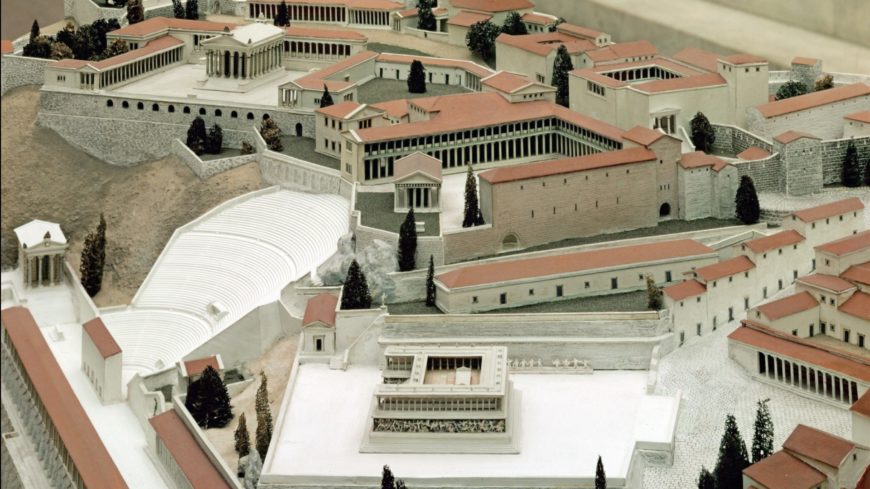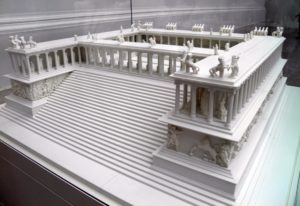The Pergamon Altar, c. 200-150 B.C.E., 35.64 x 33.4 meters, Hellenistic Period (Pergamon Museum, Berlin); speakers: Dr. Beth Harris and Dr. Steven Zucker
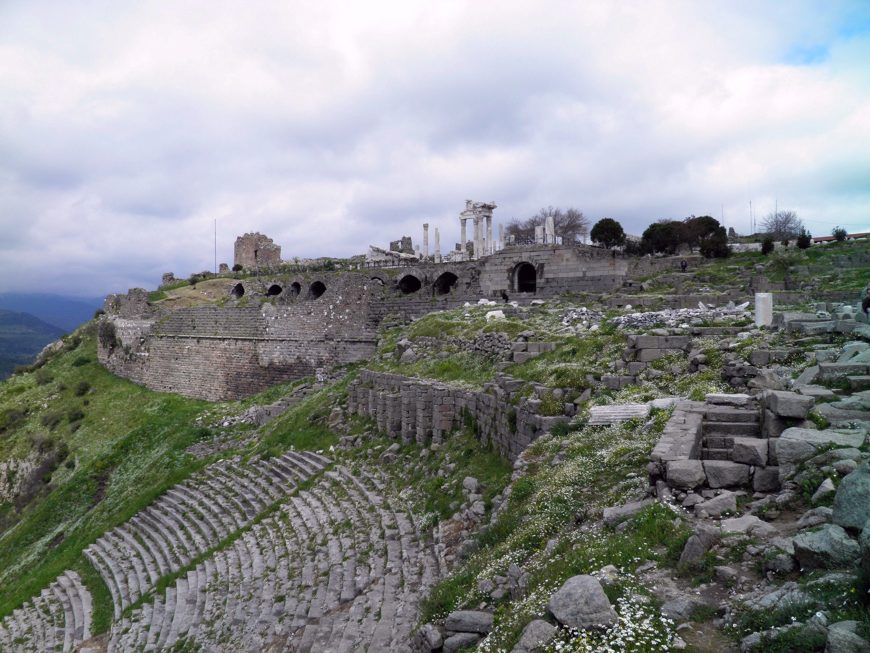
Acropolis, Pergamon, İzmir Province, Turkey (photo: Carol Raddato, CC BY-SA 2.0)
But Ge [goddess of earth] . . . brought forth the giants, whom she had by Uranus [god of the sky]. These were matchless in the bulk of their bodies and invincible in their might; terrible of aspect did they appear, with long locks drooping from their head and chin, and with the scales of dragons for feet.—Apollodorus, Library 1.6.1
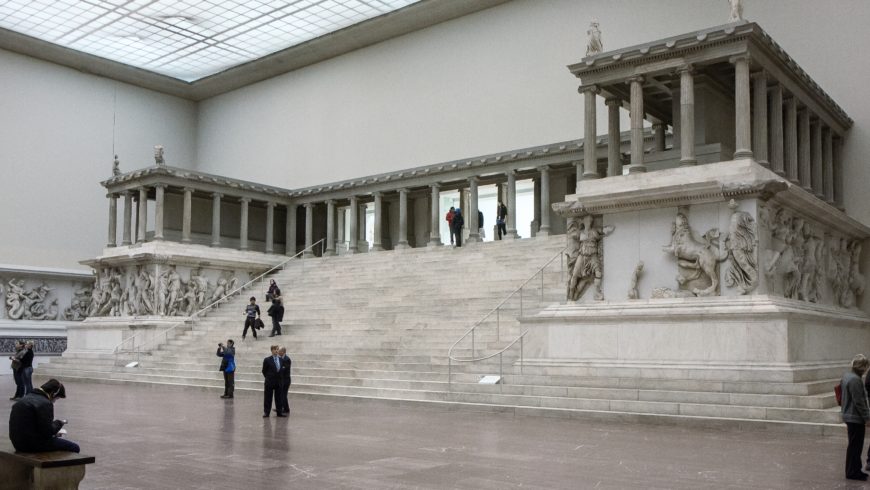
Pergamon Altar (today in the Pergamon Museum, Berlin, photo: Garret Ziegler, CC BY-NC-ND 2.0)
The battle between the gods and giants
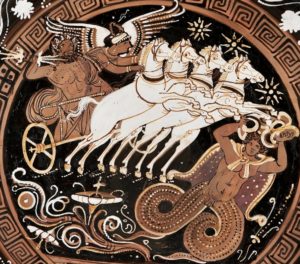
Battle between the Gods and Giants (detail), Krater with Gigantomacy scene, classical period, Ancient Greece (Museo Arqueológico Nacional, Madrid)
The ancient Greeks represented the mythological battle between the Olympian gods and the giants in a wide variety of media—from miniature engraved gemstones and vase paintings, to over-life-sized architectural sculptures.
Perhaps the most famous and well-preserved of these decorates the Pergamon Altar. The Altar once stood in a sacred precinct on the acropolis of the ancient city of Pergamon (on the west coast of modern-day Turkey), which was ruled by the Attalid dynasty from 282–133 B.C.E.
In comparison to other Hellenistic kingdoms (kingdoms formed after the death of Alexander the Great in 323 B.C.E. and stretching from the eastern Mediterranean to Central Asia), Pergamon emerged relatively late on the scene. Monumental building projects—including the Altar—served as an important way for the Attalids to stake their claim as legitimate inheritors of Alexander’s empire and, by extension, the legacy of Classical Greece.
In the early 20th century the Altar found a new home in Berlin, Germany—2,677 kilometers from its original location—where it has remained on view since 1930 as the centerpiece of the museum bearing its name (see end note below and learn more here about how the altar ended up in Berlin). [1]
The Altar’s architectural framework alone is impressive—it comprises a monumental Π-shaped structure surrounded by columns and accessed by a grand staircase. However, its most eye-catching feature is undoubtedly the frieze, a massive 113 meters long and 2.3 meters high marble high-relief that wraps around the building’s entire exterior and depicts the mythological battle between the Gods of Mount Olympus and Giants.
The battle, known as the gigantomachy—from the ancient Greek γίγαντες (“giants”) and μάχη (“battle”)—represented a crucial shift for the ancient Greeks: the old religion, which was rooted in the natural world (for example, Ge, the earth goddess and mother of the giants), was overthrown by the new, civilized order of the Olympian gods (for example, Zeus, Athena, and others). According to the myth, the gods received a prophecy that the giants could only be defeated with the help of a mortal. Zeus (assisted by Athena), called upon the hero Herakles who dealt the decisive blow by shooting them with arrows. [2] Over time, the visual tradition of the gigantomachy expanded to include the presence of other Greek heroes, who also aided the gods.
Viewing the Altar
The approach
Ancient viewers would have first approached the Altar from its rear, where the gigantomachy’s main protagonists—the god Zeus and goddess Athena assisted by the hero, Herakles—decisively defeat their giant antagonists. From this view, the figures in the relief appear inaccessible as they tower above—their over-life-sized bodies often twisting into near-impossible positions in the midst of battle. While the stepped platform made it possible to access the frieze up close, this would only have placed viewers in uncomfortable proximity to the immortal skirmish.
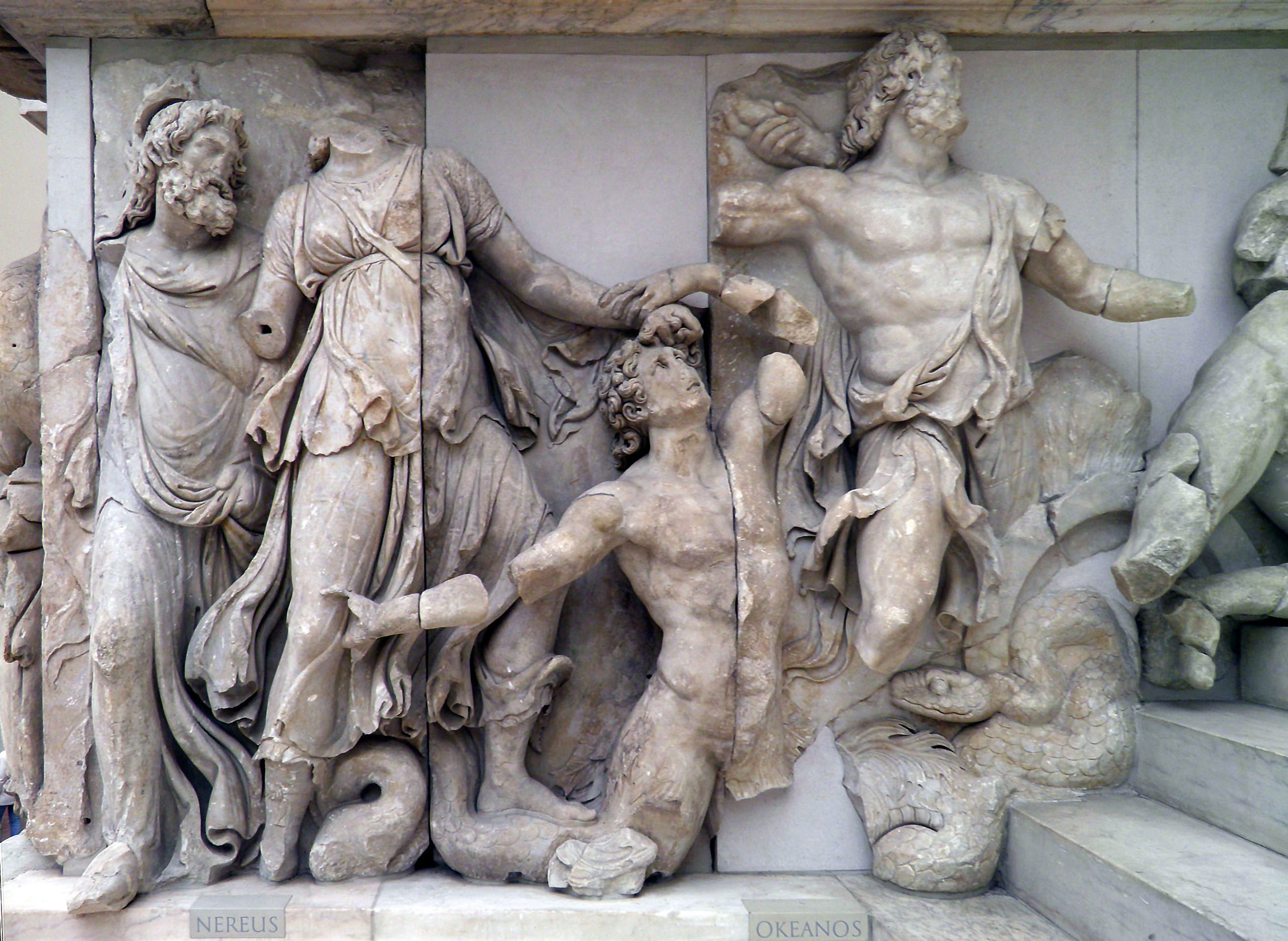
From left to right, figures associated with water: Nereus and Doris, Oceanos, and part of Tethys(?). North side of grand staircase, Pergamon Altar (photo: Carole Raddato, CC BY-SA 2.0)
The sides of the altar
As visitors continued along either side of the Altar they encountered gods and goddesses thematically assembled (for example, the twin gods Apollo and Artemis with their mother Leto). Despite the Altar’s fragmentary state of preservation, many of the figures can be identified—now, as in ancient times—through inscriptions included above (in the case of the gods) and below (in the case of the giants) the frieze.
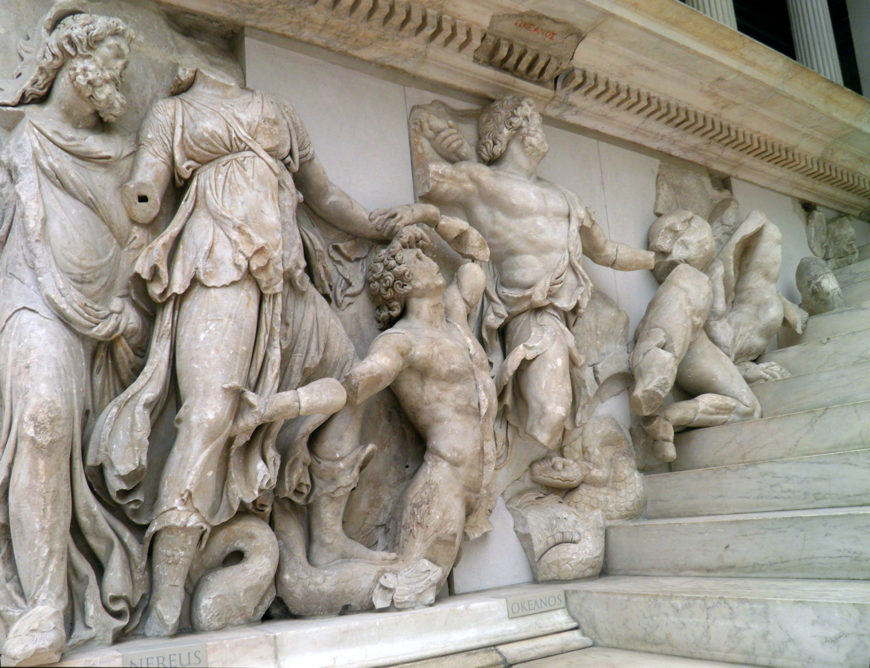
From left to right, figures associated with water: Nereus and Doris, Oceanos, and part of Tethys(?). Giants kneel further to the right. North side of grand staircase, Pergamon Altar (photo: Carole Raddato, CC BY-SA 2.0)
The Front of the Altar
Once ancient viewers reached the Altar’s front the characters began to increasingly invade their space, projecting outwards to the point where some giants (such as those battling water divinities on the north side) even kneel on the steps. It’s as if they are inviting us to join the terrifying conflict as we ascend. Despite the immense number of figures on the frieze, each panel manages to offer new discoveries for its viewers.
A battle for Hellenistic times
This version of the gigantomachy is characteristic of the Hellenistic style (Greek art dating from c. 323 to 31 B.C.E.). It is highly dramatic, both in terms of the overtly exaggerated dynamism of the figures’ bodily positions and the pathos exhibited by their expressions. The frieze, and its enigmatic central characters, first draw viewers in via the two central panels featuring the god Zeus and the goddess Athena.
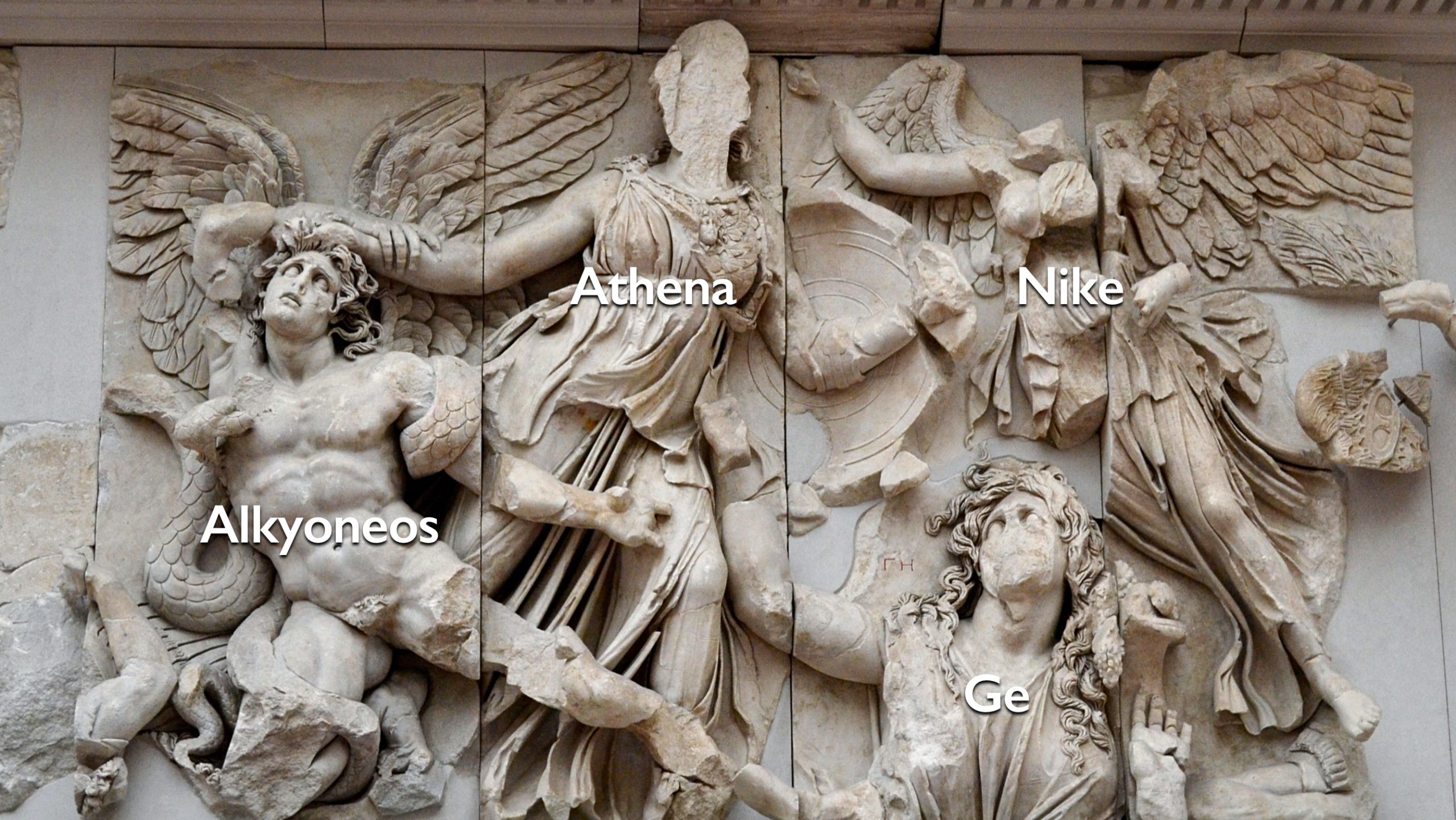
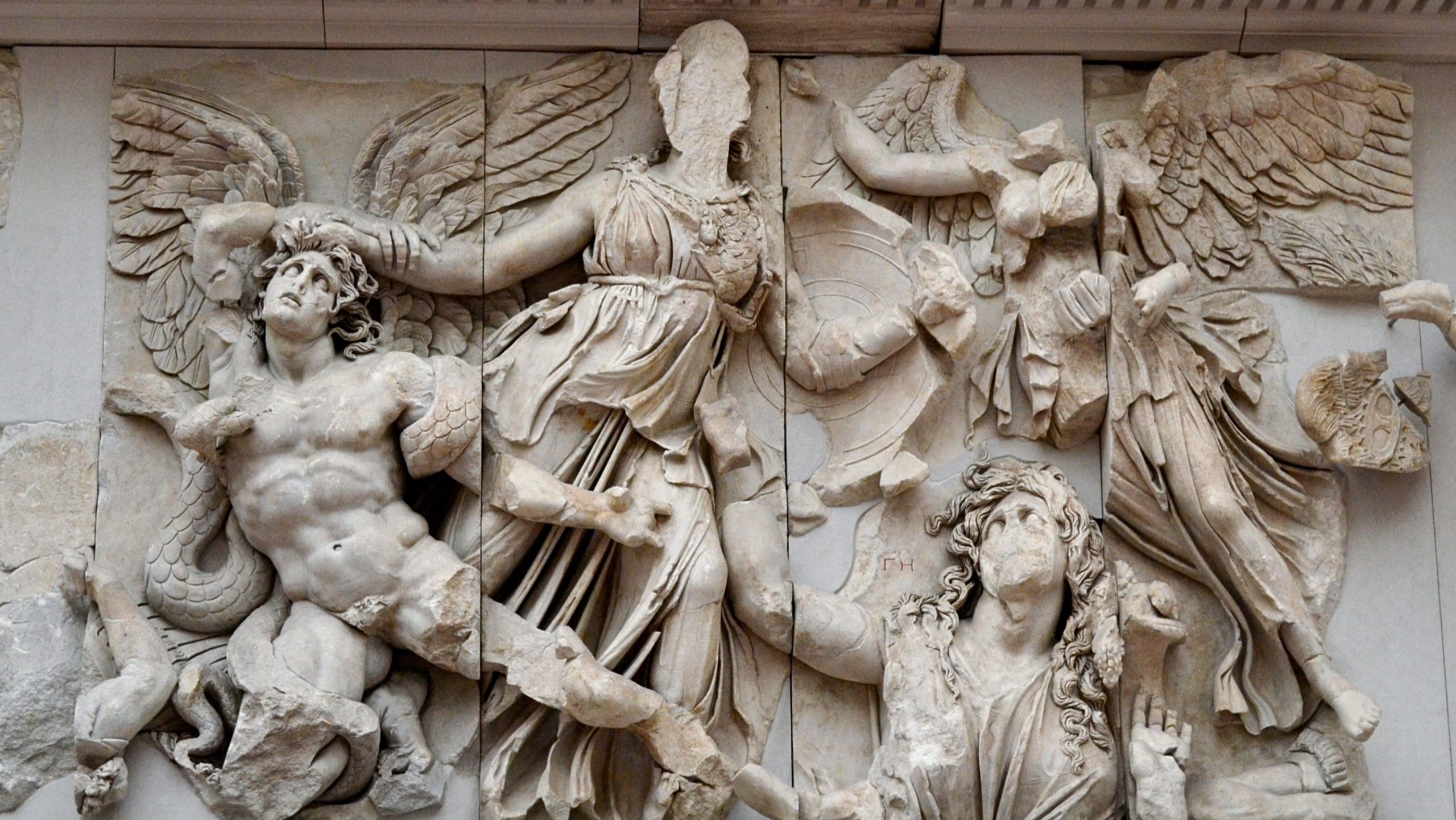
The goddess Athena grasps the giant Alkyoneos by his unruly wavy hair, pulling his face to the left. His right arm grasps in vain at Athena’s forearm. A serpent, the agent of Athena, restrains the giant’s body and simultaneously exposes his anatomy to the viewer. Alkyoneos kneels on his right leg, while his left leg extends outwards, crossing over Athena’s striding form. His face, with its wrinkled brow and open mouth, exaggerates his suffering. It is framed by the interlocked arms of giant and goddess as well as by the giant’s wings, which fill the top of the panel in low relief. Ge, goddess of the earth and mother of giants, emerges from the ground to beg for her son’s life. Notably, the earth goddess is the only figure to be identified with an inscription on the frieze itself (rather than above or below, as with the other gods and giants) emphasizing her role as an intermediary. Nevertheless, Nike, goddess of Victory, has already flown in to crown Athena, sealing Alkyoneos’ fate.
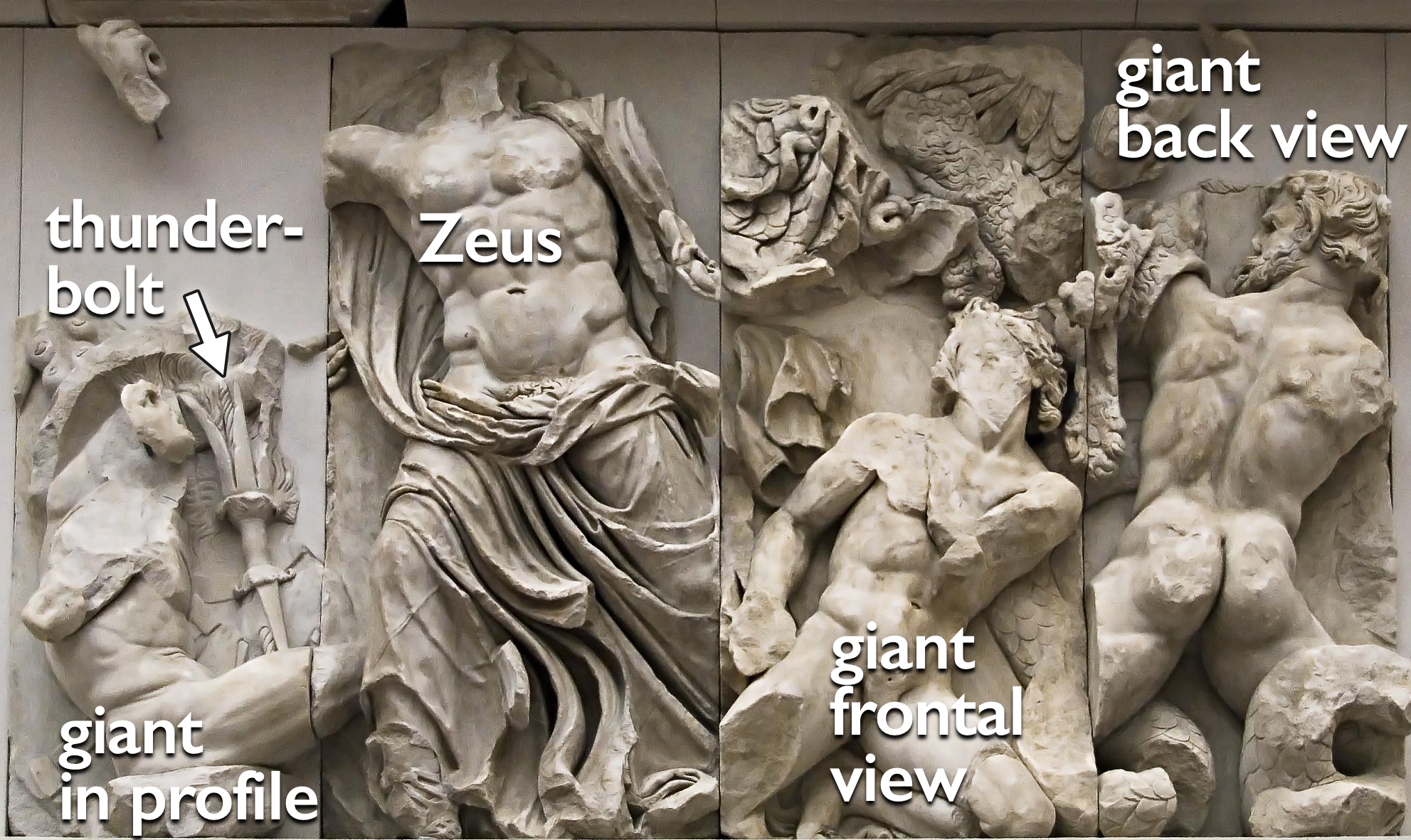
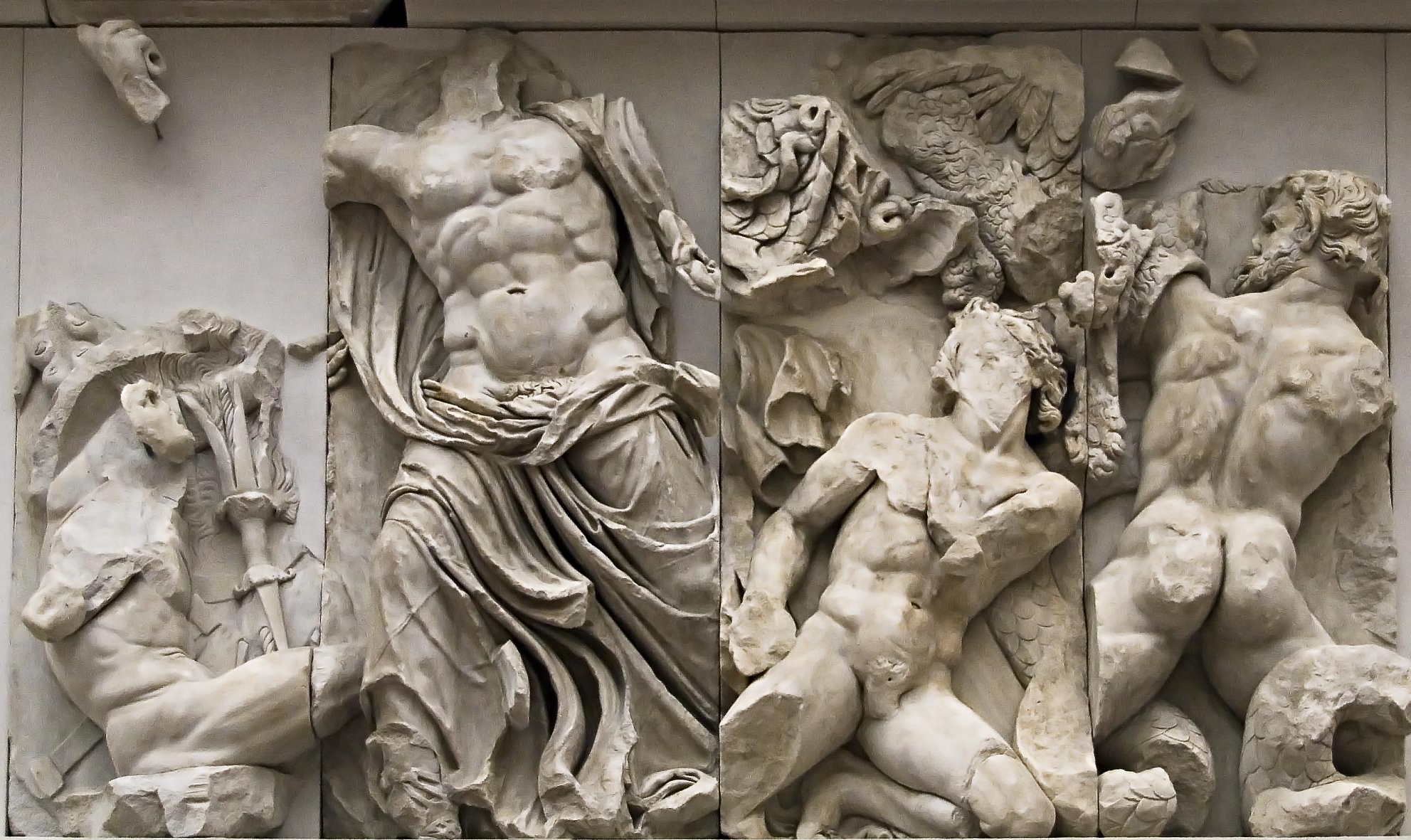
The giants from the Zeus panel are rendered from three distinct perspectives. One, directly to Zeus’ left, kneels on his left leg, his body not nearly as extended as Athena’s opponent. A second, furthest from Zeus, shows us his muscular back, buttocks, and serpentine legs as he turns toward the god with his bearded face in profile. The third, to Zeus’ right, has been pierced by Zeus’ weapon, the thunderbolt, and sits in profile view, wounded on the ground. Although barely preserved, just to the right of this wounded giant the figure of Herakles can be detected by a paw from the Nemean lion’s skin (an attribute of the Greek hero Herakles). Herakles’ essential role in the gigantomachy has been appropriately emphasized through his proximity to Zeus. (In fact, the Attalid’s choice to monumentalize this particular myth was likely tied to the presence of the Greek hero who was the father of Telephos, the mythological founder of Pergamon).
Just as impressive as their dynamic poses, these two panels depict a diversity of giant types—from human to animal. On the Altar, a giant could be fully humanized, and even wear armor. But many more are anguiform (snake-like) and some possess further animalistic features. A few, besides, are even more overtly animal-like, almost monstrous.
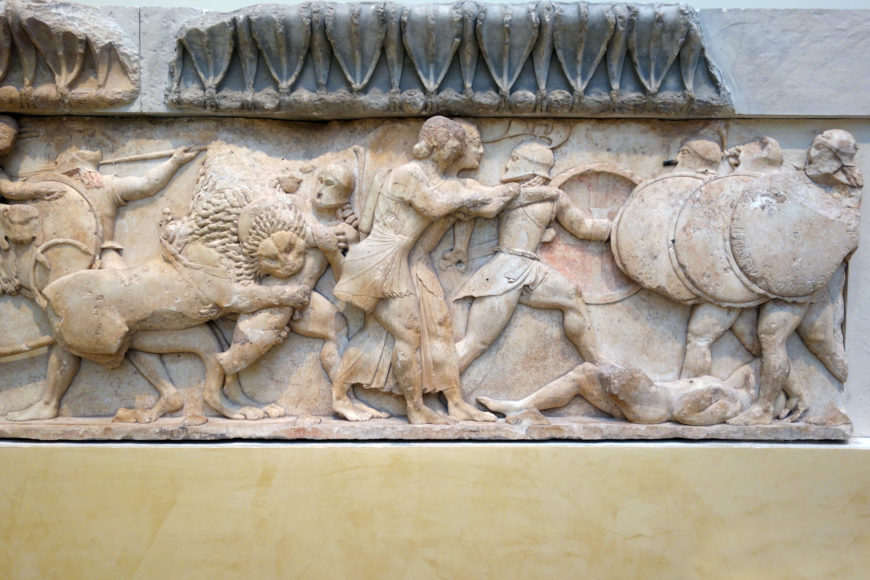
Detail of the north frieze showing the god Apollo and goddess Artemis advancing towards a fleeing giant, Siphnian Treasury, c. 530 B.C.E., Sanctuary of Apollo, Delphi, Greece (photo: Steven Zucker, CC BY-NC-SA 2.0)
Visual traditions of the gigantomachy
Some of the earliest representations of the gigantomachy, such as the frieze from the Treasury of the Siphnians at Delphi (c. 525 B.C.E.), appear to follow Hesiod’s Theogony, in which he describes the giants as born wearing “gleaming armor with long spears in their hands.” [3] For example, a detail from the north frieze shows the god Apollo and goddess Artemis advancing towards a fleeing giant, who turns back to look at them. The Archaic-style giants are uniformly depicted in armor (similar to the that worn by hoplites, the foot soldiers of ancient Greece) and face the gods almost as equals. To the left of this scene, a lion—pulling a goddess’s chariot—attacks a giant. The frieze is dominated by overlapping profiles of gods and giants who stride toward one another but there is little indication of physical engagement between the figures, save for the lion and the giant.
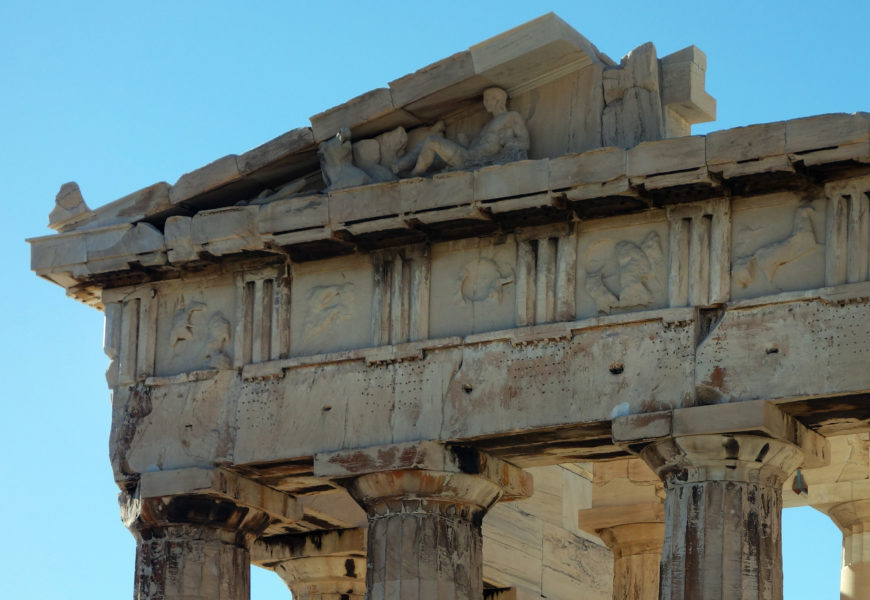
East metopes showing a portion of the gigantomachy, Iktinos and Kallikrates, Parthenon, Acropolis, Athens, 447–432 B.C.E. (photo: Steven Zucker, CC BY-NC-SA 2.0)
Over time and in countless artworks, artists reimagined the gigantomachy to include a variety of characters, interactions, and attributes, eventually making the Pergamon Altar version possible. One of the most recognized examples of the gigantomachy, on the east metopes of the Parthenon (447–438 B.C.E.), promoted the Athenians as civilizers and preservers of Greek culture over the barbarous Persian forces. Following the Persian wars (545–448 B.C.E.) the attire of the giants changed to include animal skins (difficult to see on the metopes today). The Classical-style Parthenon metopes have evolved from the Archaic depictions of the Siphnian treasury to emphasize a clearer distinction between god and giant. The gods are generally portrayed above the giants; the giants have shed the majority of their hoplite armor in favor of donning animal skins and wielding rocks or clubs, which connect them to the natural world.
The Athenian Parthenon, and the city of Athens more broadly, became incredibly influential in both the Classical and later periods. Hellenistic rulers, including the Attalid kings of Pergamon, sought to emulate Athens and, significantly, forged visual connections between their own newly formed kingdoms and the established cities of mainland Greece. The Pergamene Acropolis contained numerous sculptural and architectural references to Athens, including an over life-sized marble copy of the colossal chryselephantine (gold and ivory) Athena Parthenos that once stood inside the Parthenon. The Altar too may have contained compositional allusions to the renowned Athenian temple, namely in the striding figures of Athena and Zeus, whose poses resemble that of Athena and Poseidon on its west pediment (see a reconstruction drawing of it here).
On the Parthenon, the Athenians used myths to provide commentaries on their contemporary reality. The barbaric giants, decisively defeated by the Olympian gods and assisted by Greek heroes, served as an appropriate visual metaphor for the Persians, who had desecrated the sacred sites of Greece including the Athenian Acropolis. Similarly, were the figures of giants on the Altar meant to evoke the enemies of Pergamon—the Gauls and the Macedonians?
From myth to reality: the Pergamon Altar as a victory monument
Prior to the construction of the Altar, the first king of Pergamon, Attalos I, set up monuments to commemorate his victory over the Gauls and legitimize his rule. The fact that his sons (Eumenes II and Attalos II) also fought the Gauls has prompted scholars to consider the Great Altar as another victory monument.
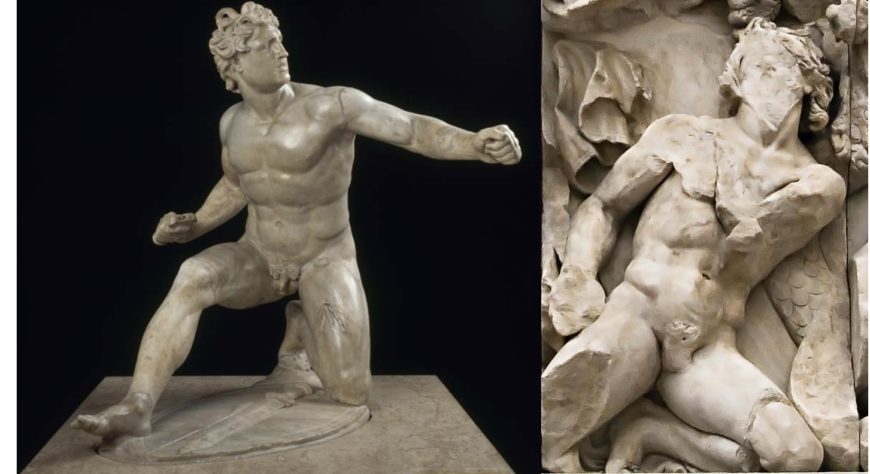
Left: Wounded Gaul from the monument of Attalos I (Roman copy, c. 3rd–2nd century B.C.E. (Musée du Louvre) ; right: detail of Zeus’ opponent (a giant), Pergamon Altar, c. 1971–39 B.C.E. (Staatliche Museen, Berlin)
Single figures of Gauls from the earlier victory monuments that survive in the form of Roman copies bear clear resemblance to the giants from the Altar frieze. Compare the thick, curly, wild locks of hair of the Wounded Gaul in the Louvre to that of a giant from the Zeus panel. The Gauls were known to have covered their hair with a watered down plaster mixture, giving it a thickened rough appearance. [4] While the giants on the Altar were not exact quotations of the Gauls, their agonized twisting figures likely reminded viewers of the earlier monuments, some of which were probably erected nearby.
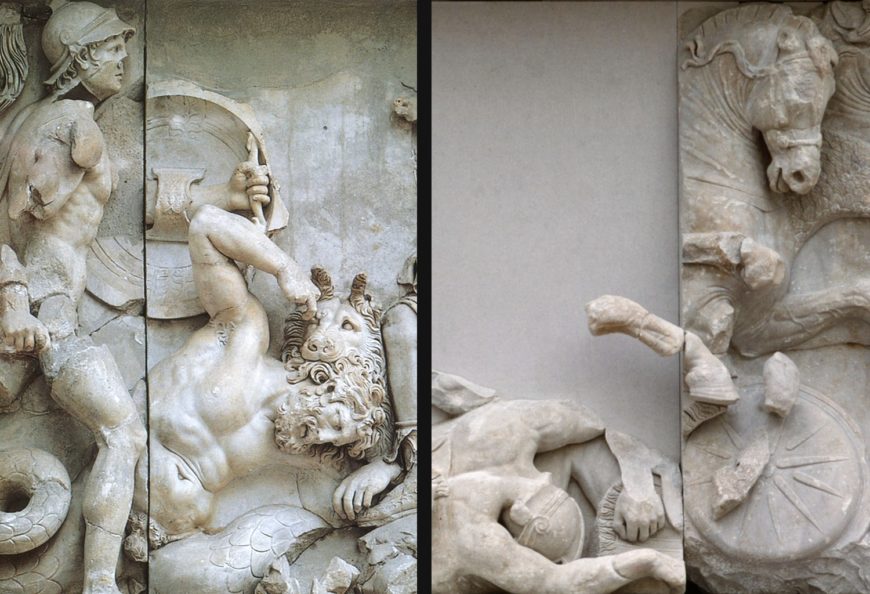
Left: Helmeted giant striding forward with shield; right: trampled giant with shield, Pergamon Altar, c. 197–139 B.C.E. (Staatliche Museen, Berlin)
The armored giants in the frieze evoke comparison with another contemporary adversary. Two giants from its east side—one striding toward the goddess Artemis bearing a shield, and a second trampled beneath Hera’s chariot, also holding a shield—bear characteristically Macedonian armor. The shield of the trampled giant is adorned with a starburst, a common emblem of the Macedonians. [5]
The Altar is not alone in alluding to victory of Pergamon over the Macedonians—images of their armor also appear at the Sanctuary of Athena, located just north of the Altar precinct on the Pergamene acropolis. The emphatic inclusion of these attributes may have served as a means to quash rumors that Eumenes II was considering peace or an alliance after the Third Macedonian War (172–168 B.C.E.), in which the Attalids had fought alongside the Romans. Furthermore, it has been suggested that the Altar—similar to other multifunctional structures in cities and sanctuaries throughout the Greek world—also served as a treasury for arms and armor captured in the Gallic and Macedonian wars (among others). These reminders—both real and sculpted—would have strengthened viewers’ visual associations between the enemies of Pergamon and the giants on the Altar frieze.
As ancient visitors traversed from the rear to the front of the Altar they witnessed the metamorphosis of giants from overtly monstrous anguiform and animal-headed representations to fully anthropomorphic figures equipped with the arms and armor of Attalid enemies. [6] Taking its cue from the example of the Classical Parthenon, the Pergamon Altar went one step further in encouraging its viewers to visually compare contemporary adversaries with the fearsome giants. Ultimately, in conflating a mythological battle with contemporary Attalid victories the Altar elevated the triumph of Pergamon to that of the gods.
End note
Notes
[1] As of writing, the Pergamon Museum is currently under renovations until 2024. The Altar is not currently on view, but initiatives have been taken to make the altar accessible to the public through a 3D model and temporary exhibition building featuring a panorama of the city in Roman times.
[2] Apollodorus, Library, In Loeb Classical Library, translated by Sir James George Frazer (New York: G.P. Putnam’s Sons, 1921) 1.6.1-2.
[3] Hesiod, Theogony, translated by M.L. West (New York: Oxford University Press, 1988), pp. 173–206.
[4] Bernard Andreae, “Dating and Significance of the Telephos frieze in Relation to the Other Dedications of the Attalids of Pergamon,” In Pergamon: The Telephos Frieze from the Great Altar, edited by R. Dreyfus and E. Schraudolph (San Francisco: Fine Arts Museum of San Francisco, 1996-1997), pp. 122–123.
[5] ]For example, the star also adorned Macedonian coinage, such as on a silver tetradrachm struck under Philip V (186/5–183/2 B.C.E.), now at the Museum of Fine Arts, Boston.
[6] Emma Aston, Mixanthrôpoi: Animal-human hybrid deities in Greek religion (Liège: Centre International d’Étude de la Religion Grecque Antique, 2011), p. 19. She argues that three themes are often used to address the animal/human relationship: “combat, bestiality, and metamorphosis.”
Additional resources
3D Model of the Pergamon Altar, Staatliche Museen zu Berlin (2016)
The recent story of the Pergamon Altar (Google Cultural Institute)
What happened in Pergamon (Google Cultural Institute)
Carlos A. Picón and Seán Hemingway, eds. Pergamon and the Hellenistic Kingdoms of the Ancient World (New York: Metropolitan Museum of Art, 2016)
Lucilla Burn, Hellenistic Art: From Alexander the Great to Augustus (London: British Museum Press, 2004)
R. R. R. Smith, Hellenistic Sculpture: A Handbook (London: Thames & Hudson, 1991)
Smarthistory images for teaching and learning:
[flickr_tags user_id=”82032880@N00″ tags=”pergamon,”]

